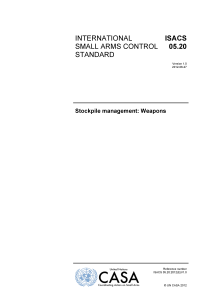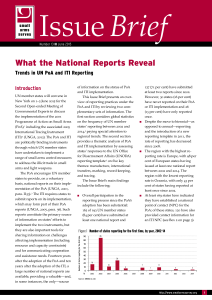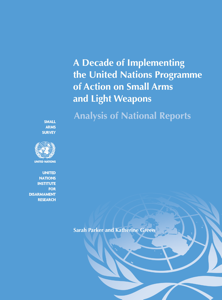Programme of Action
The United Nations Programme of Action on Small Arms and Light Weapons
The UN Programme of Action to Prevent, Combat and Eradicate the Illicit Trade in Small Arms and Light Weapons (PoA), adopted in 2001, remains the cornerstone of global efforts to address the widespread and devastating impact of small arms and light weapons (SALW). It provides a comprehensive framework for national regulation, international cooperation, and capacity-building to combat the illicit trade and misuse of these weapons, which continue to fuel armed violence and instability in many parts of the world.
Since its adoption, the international community has gathered regularly to assess progress and identify gaps in implementation. It has hosted three Review Conferences in 2006, 2012, and 2018, with a fourth expected in 2026. In addition, eight Biennial Meetings of States (BMS) have taken place, the most recent being BMS9 in June 2024 in New York (more information here). hese meetings have helped shape practical guidance, encourage voluntary reporting, and reaffirm the commitment of Member States to the objectives of the PoA. Complementary mechanisms such as the International Tracing Instrument and the recommendations of a Group of Governmental Experts on Brokering Controls.
In Asia and the Pacific, the proliferation of small arms and light weapons has been driven by a range of factors, including unresolved armed conflicts, criminal networks, and porous borders. While regions like South and Southeast Asia continue to face challenges posed by insurgencies, terrorism, and organized crime, certain Pacific Island countries have also experienced cycles of armed violence and insecurity. Though large-scale trafficking is less prevalent in the Pacific, countries such as Fiji, Bougainville in Papua New Guinea, and the Solomon Islands have faced social and economic disruption linked to the misuse of SALW.
Monitoring the implementation of the PoA relies largely on national reports submitted by Member States. As of May 2025, more than 30 countries in Asia and the Pacific have submitted at least one national report since 2001. Australia has demonstrated particular commitment by submitting reports annually. China, Japan, India, and others have also participated consistently, though reporting gaps remain, particularly among smaller or resource-constrained states. These reports provide valuable insights into the progress made on legislative reform, weapons tracing systems, stockpile security, and public awareness efforts.
One of the ongoing challenges in the region is the need for more effective cross-border cooperation, especially in customs enforcement, intelligence sharing, and capacity-building. Regional organizations such as ASEAN, the Oceania Customs Organisation (OCO), and SAARC play an increasingly important role in fostering collaboration among states and aligning national efforts with international standards. As preparations for BMS9 continue, there is a renewed emphasis on strengthening regional coordination, ensuring universal participation in reporting, and providing technical assistance to those most in need.
In sum, the PoA continues to serve as a critical tool for preventing armed violence and enhancing human security in Asia and the Pacific. Its success depends not only on high-level political commitment but also on sustained action at the national and regional levels. As the global community looks ahead to the next review cycle, the focus must remain on closing implementation gaps and promoting practical, cooperative measures that reduce the illicit flow and misuse of small arms and light weapons.
Featured Publications





